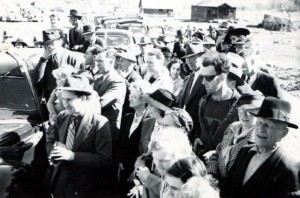You may be familiar with the urban legend of the time-traveling hipster. It stems from an image that has been circulating on the internet for a few years now. But did you know that the hype generated by this uncanny snapshot teaches an important lesson about Six Sigma?
 It all goes back to a black and white photo taken in 1941 in Gold Bridge, British Columbia. It shows the crowd that was celebrating the reopening of the South Fork Bridge. The picture displays just what you would expect from a group of respectable citizens in 1941. Men are wearing coats and ties, and women are wearing formal hats and sturdy overcoats. Nothing looks out of place, except for something just right of center.
It all goes back to a black and white photo taken in 1941 in Gold Bridge, British Columbia. It shows the crowd that was celebrating the reopening of the South Fork Bridge. The picture displays just what you would expect from a group of respectable citizens in 1941. Men are wearing coats and ties, and women are wearing formal hats and sturdy overcoats. Nothing looks out of place, except for something just right of center.
One of these fascinated folks is not dressed like the others. His attire is not just less formal than the rest of the group, he seems to be wearing clothes from another time period. He’s dressed in what looks to be a printed T-shirt and weirdly hip sunglasses. It appears that he walked out of a Depeche Mode concert in 1990 and stepped onto a bridge in British Columbia in 1941. The photo has been considered by some as proof of the reality of time travel.
What explains the hipster in the photo? Is he proof of the possibility of time travel? Is he a Photoshop hoax? Is it all just a misunderstanding?
It turns out there is an explanation for this misplaced hipster. Unfortunately it’s not nearly as exciting as time travel.
The items that make the man stand out in the crowd – the camera, his haircut, and the edgy sunglasses – were available to everyone in 1941. Even his t-shirt, which might appear to be printed but is a sewn-on logo, was from a popular sports team of the era, the Montreal Maroons. The hipster stands apart not because he traveled through time, but because he simply made different choices than the people around him, allowing him to “stand out from the crowd.”
What’s the Connection to Six Sigma?
When used correctly, Six Sigma can assist your organization to improve its processes and provide a high level of quality that separates your product or service from the competition. Like the hipster, Six Sigma uses resources that all of your competitors have access to, but using them more wisely can allow you to stand out.
The most important of these resources is the organization’s employees. By giving select employees an active role in the Six Sigma quality improvement process, organizations can enhance their level of quality in house.
Roles employees can play in the Six Sigma process include:
Sponsor – This is the project owner who assembles the Six Sigma project team. The sponsor gives guidance, removes obstacles and provides resources.
Champion – This is a senior-level leader who supports a project team by distributing resources and helps resolve any conflicts with other departments.
Black Belt – These are full-time Six Sigma professionals who help identify projects that drive key business initiatives. They also lead team projects and train other employees in Six Sigma.
Green Belt – These employees have been trained in Six Sigma methodology and have other full-time responsibilities at the company. They work under the direction of Black Belts.
Team Member – These employees are familiar with Six Sigma but may have no formal training. They provide the team with in-depth expertise about how the process works.
Six Sigma helps companies use the resources that are available to everyone – including their own employees – to enhance the quality of their products and services. The same way the hipster used clothes available to everyone to stand apart from the crowd and get people talking over 70 years later.
No, Six Sigma may not be quite as exciting as time travel, but it can help transform your company, get people talking and allow you to be a champion in your organization.
